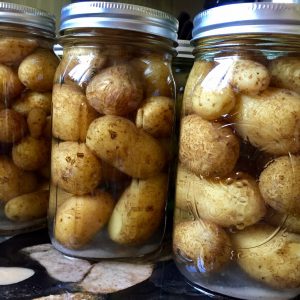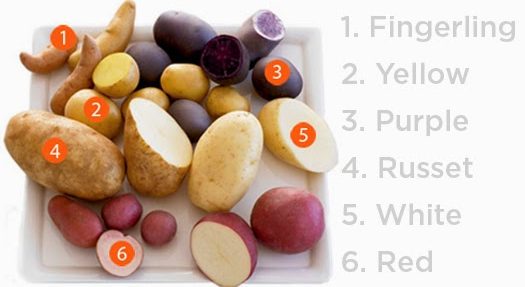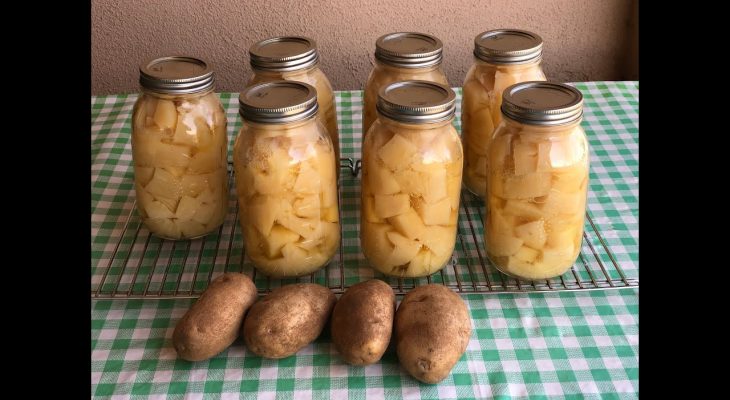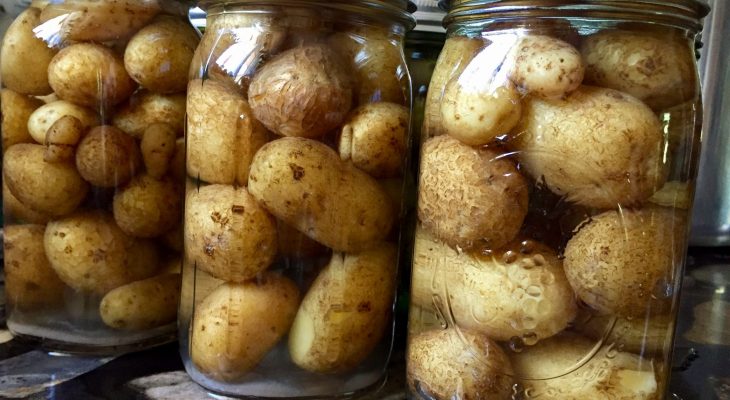Knowing how much natural starch is in a potato may make the difference between a perfect clear jar of potatoes or one full of a cloudy starch. There are other factors like soaking while you cubed them or making sure to follow the correct timing for processing them in a pressure canner. An over-processed potato no matter the variety will make the liquid they are canned in look cloudy.
First here is my research about the starch content of the most popular varieties of potatoes.
Potato Types
· High starch potatoes: Russet potatoes (sold as Eastern or Idaho) have a high starch content with low moisture. These potatoes bake mealy and fluffy, and are the best choice for mashed potatoes and baked potatoes. But high starch potatoes also absorb water, so they fall apart when boiled, making them not the best for canning. Essentially you are boiling these potatoes in the jars.
· Medium starch potatoes are called all-purpose potatoes. They’re moister than high-starch potatoes and hold their shape a bit better. Best roasted or made into gratins. Yukon Gold, Purple, White (round or oval) and Yellow Finn potatoes. They aren’t as fluffy as russet potatoes, but have great flavor. Better for canning since they retain their shape but will have some starch cloudiness if not properly pre-blanched when canning.
· Low-starch potatoes and high moisture include Red, Red bliss, California Fingerlings, some White potatoes, and most new potato varieties. These potatoes are most often boiled or roasted and used in potato salad because of their creamy texture. They hold together well after being cooked and canning these will produce a clearer liquid.

Potato
Instructions
- When selecting potatoes to be packed whole choose potatoes 1 to 2 inches in diameter.
- Wash and peel potatoes. Place in ascorbic acid solution to prevent darkening. Ascorbic acid is a powder that you can purchase and is found in Fruit Fresh from Ball.
- (Use 1 teaspoon per gallon of water as a treatment solution) Do not leave them in there long (not overnight) as they will absorb liquid.
- Cut into 1/2-inch cubes. Drain. To keep the starch content low after canning boil a pot of water, put the potatoes into the water for 2 minutes and drain again. For whole potatoes, boil 10 minutes and drain.
Filling jars:
- Add 1 teaspoon of salt per quart to the jar, if desired (I use canning salt or kosher rather than table salt). Fill jars with hot prepared potatoes, leaving no more than 1-inch headspace.
- Cover hot potatoes with FRESH boiling water, leaving 1-inch headspace and covering all pieces of potato.
- NOTE: Do not use the water you cooked the potatoes in; it contains all that starch you were trying to get rid of.
Processing:
- Make sure your rack is on the bottom of the canner and place the jars in the pressure canner. Lock the lid and turn up the heat bring the canner to a boil.
- Vent steam for 10 minutes, then close the vent by adding the weighted gauge or pressure regulator (for dial gauge canner). Process for 35 minutes for pints and 40 minutes for quarts at 10 lbs of pressure (11 lbs for dial gauge canner).
- (Adjust pressure for altitude) When complete turn off the heat and let pressure return to zero naturally. Wait two minutes longer and open vent.
- Remove canner lid. Wait 10 minutes then remove jars and place on dishtowel in a place that they will sit overnight to cool. Do not touch or move them till the next morning. Your food may still be boiling inside the jars. That is normal!
Sealing:
- Sometime in the next hour your jars will be making a "pinging" or "popping" noise. That is the glass cooling and the reaction of the lids being sucked into the jar for proper sealing. Some recipes may take overnight to seal. Check your lids and reprocess any jars that did not seal. Remove rings for storage.
Labeling:
- Make sure to label your jars after they have cooled with the name of the recipe and the date canned. If you want to use the shrink labels in the picture you can order them Here!
- Pick firm potatoes and keep them in the dark for storage other than canning!
- Regardless of variety, all potatoes should feel heavy and firm, never soft, wrinkled, or blemished. And try not to buy potatoes in plastic bags since it’s hard to evaluate them.
- Store potatoes away from light in a place that’s cool (but not cold) and dry. New potatoes can be refrigerated for a few days, but any potato that’s stored too long at such a low temperature will take on an unpleasant sweetness as the starch converts to sugar.
- Refuse to buy potatoes that show even a hint of green. They’ve been “lightstruck.” The green indicates the presence of solanine, which is produced when potatoes are exposed to light, either in the field or after harvest. This mildly poisonous alkaloid has a bitter flavor that can cause an upset stomach. If your potatoes turn green after you get them home, peel off all traces of the colored flesh before cooking.











One Comment
Chad
Posted on: June 9, 2019Thank you for your helpful site. The water in the jars of my first canned potatoes look a little cloudy but the lids are sealed. Is it safe to assume the potatoes are still good?